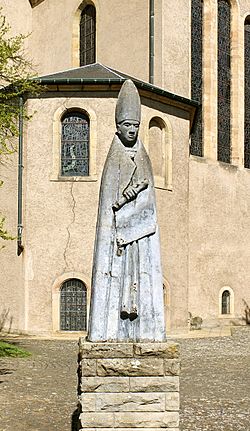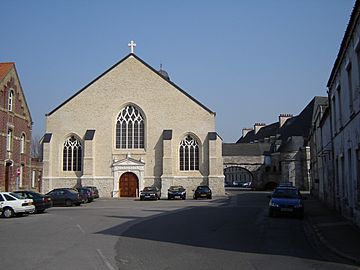Willibrord facts for kids
Quick facts for kids SaintWillibrord |
|
|---|---|

Statue of St Willibrord at Echternach
|
|
| Bishop | |
| Born | c. 658 Northumbria |
| Died | 7 November 739 (aged 81) |
| Venerated in | Roman Catholic Church Eastern Orthodox Church Anglican Communion Old Catholic Church |
| Major shrine | Echternach |
| Feast | 7 November |
| Attributes | Dipping staff into cask |
| Patronage | Convulsions; epilepsy; epileptics; Luxembourg; Netherlands; Archdiocese of Utrecht, Netherlands |
Willibrord (born around 658 – died November 7, 739) was an Anglo-Saxon missionary. He is famous for bringing Christianity to the Frisians in what is now the Netherlands. People often call him the "Apostle to the Frisians." He became the first bishop of Utrecht and passed away in Echternach, Luxembourg.
Contents
Early Life and Learning
Willibrord's father, Wilgils, was a Saxon from Northumbria. He had recently become a Christian. Wilgils decided to dedicate his son, Willibrord, to God's service. He sent Willibrord to the Abbey of Ripon when he was young. His father then built a small church near the Humber river.
Willibrord grew up learning from Wilfrid, who was the Bishop of York. Later, he joined the Benedictine monks. When he was about 20 years old, he moved to the Abbey of Rath Melsigi in Ireland. This abbey was a very important center for learning in Europe during the 600s. He stayed there for 12 years, studying and preparing for his future work.
Mission to Frisia
While in Ireland, Willibrord studied with Ecgberht of Ripon. Ecgberht decided to send Willibrord and eleven other companions on an important mission. Their goal was to teach Christianity to the Frisians, who lived along the North Sea coast. At that time, the Frisians followed their old pagan beliefs. Pepin of Herstal, a powerful leader in the Frankish kingdom, asked for this mission to happen.
Trips to Rome
Willibrord made two important trips to Rome. These trips were different from regular pilgrimages. He went to Rome specifically to get permission and blessings for his missionary work.
On his first trip, he met Pope Sergius I. He asked the Pope for permission to preach the Christian message to the non-Christian people. The Pope agreed and gave him his blessing.
On his second trip, on November 21, 695, Pope Sergius I made him a bishop. This happened in the Church of Santa Cecilia in Trastevere. As a bishop, Willibrord had more authority to establish churches and spread the faith. He then returned to Frisia to continue his mission. He built a monastery in Utrecht, which became his main church. Willibrord is known as the first bishop of Utrecht.
Founding Echternach Abbey
In 698, Willibrord started the Abbey of Echternach. This abbey was built on the site of an old Roman villa. Pepin's mother-in-law, Irmina of Oeren, gave him the land for the abbey. She was a very religious woman.
Irmina had founded a convent for nuns. When a terrible sickness threatened her community, Willibrord helped them. After the sickness passed, she gave Willibrord the land in Echternach for his abbey.
Challenges and Return
Pepin of Herstal died in 714. After this, a pagan king named Radbod, king of the Frisians, took control of Frisia. He burned churches and killed many missionaries. Willibrord and his monks had to leave the area for a while.
However, after Radbod died in 719, Willibrord returned. He continued his work under the protection of Charles Martel, another powerful Frankish leader. Another famous missionary, Boniface, joined Willibrord for three years before moving on to preach elsewhere.
Legacy and Veneration
Willibrord died on November 7, 739, when he was 81 years old. He was buried in Echternach, as he had wished. People quickly recognized him as a saint.
Many people visited "Willibrord wells" along his missionary routes. They believed these wells could help heal nervous diseases, especially in children.
Feast Day and Celebrations
In the Catholic Church, Willibrord's feast day is celebrated on November 7. In England, it is celebrated on November 29. The Church of England and the Episcopal Church (US) also honor him on November 7.
Many stories of miracles are linked to him. One famous event is the "Dancing Procession" in Echternach. This special procession still happens every year on Whit Tuesday. Thousands of people participate and watch. They honor Willibrord, who is often called the apostle of the Benelux countries (Belgium, the Netherlands, and Luxembourg).

There are churches dedicated to Willibrord in different places. For example, in Gravelines in northern France, the church is named after him. It is believed that Willibrord landed there after crossing the English Channel to begin his mission. Gravelines grew around a chapel built to remember his mission.
There is also a chapel from the 1200s dedicated to Willibrord at Weissenburg Abbey, Alsace. This is where his helper, Irmina of Oeren, was also honored.
See also
 In Spanish: Vilibrordo para niños
In Spanish: Vilibrordo para niños

- Dancing procession of Echternach
- Echternach Gospels
- Anglo-Saxon mission
- The Willibrord Society promotes cooperation between Anglicans and Old Catholics


